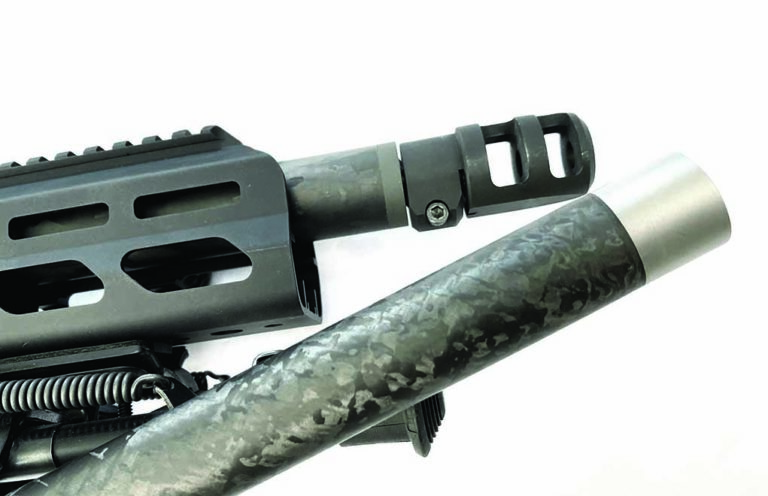
Everywhere you turn there's a carbon-fiber barrel or stock on a rifle. Does the lightweight material really prove superior to steel and wood?
Across the thousand years that people have been using guns, there have been innumerable materials used to achieve the goal of launching a projectile at a target. In the grand scheme, carbon fiber is just another material applied to that end and not specifically devoted for it.
Muskets were greasy affairs, and anyone who is a muzzleloader aficionado will be familiar with all manner of mess. These shooters use everything from animal fat and butter to wax and entrails to work on their guns and load them. Greased fabric patches are wrapped around round balls and rammed down, waiting to be fired by flint striking steel.
Mass production in the era after the Industrial Revolution saw machine guns with barrels surrounded by water tanks as a means of keeping them cool. The first composite materials saw widespread use as laminated wood or wood-impregnated resins began to see action. Plastics and aluminum were next, and their adoption in arms was slow and faced great criticism.
Some people still won’t touch a “Tupperware” gun, despite the first popular models showing up over a half-century ago. Full steel guns are getting rarer as a result of this, and only fan favorites, like the 1911, are still in common use. Today’s most popular guns make use of steel in strategic places but are otherwise constricted primarily from polymers and aluminum.
Further cutting into steel’s territory is carbon fiber.
What Exactly Is Carbon Fiber?
Some treat the material as a brand itself, a status marker showing that an individual can afford an expensive barrel. The material is quite remarkable, and what it does for rifles, in particular, is great—but not completely necessary for most shooters.
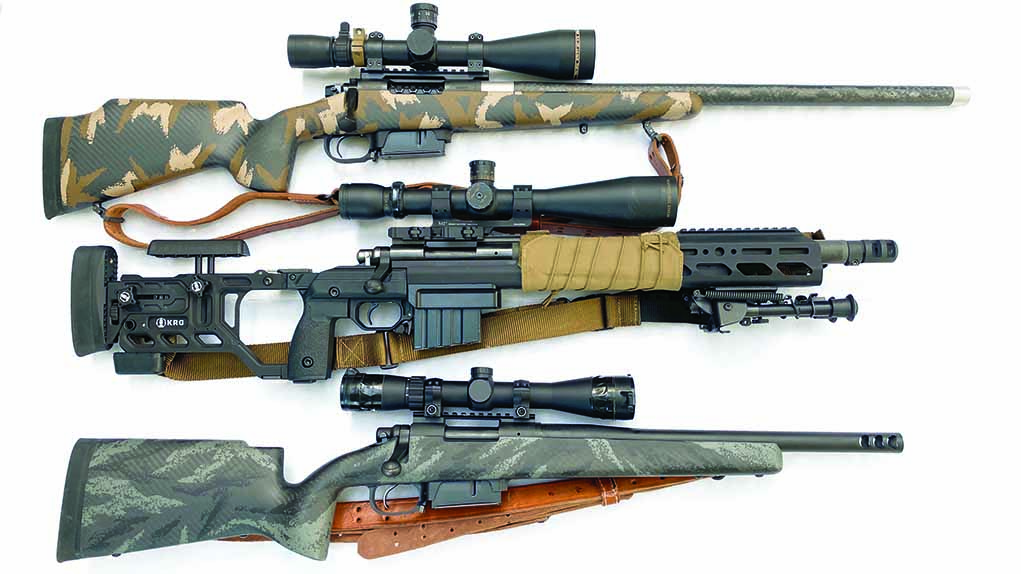
The material itself is, in layman’s terms, composed of thousands of strands, each made from carbon atoms. Surprisingly, this isn’t a new material at all, but it’s new to firearms.
The original attempts to generate it for industrial applications goes back to the early 1860s, though it didn’t reach its commercial potential until about 100 years later. It’s essentially a fabric spun into a weave that’s then filled with resins or polymerized composites to achieve a sheet of what resembles cloth. Virtually all firearm applications of carbon fiber are mislabeled and would be more appropriately called “carbon-fiber reinforced polymer,” but that isn’t quite as catchy. This is the same general technology applied to archery equipment and water sports, like kayaking and canoeing.
To make carbon-fiber barrels, most companies use a variation of wrapping it around a steel barrel, commonly called a “liner,” though it could be thought of as a super-thin barrel itself. The attachment points on a carbon-fiber barrel are steel, such as where it threads into the receiver, and at the muzzle where you can thread on a brake or suppressor. Different companies do their wraps in special ways, and you can sometimes identify a brand by the appearance of the pattern in the fibers.
As far as stocks are concerned, many aren’t actually made 100 percent out of carbon fiber, but are instead a shell made of another composite sheathed in carbon fiber to add strength and rigidity. Other companies laminate layers of carbon fiber into fiberglass or other like materials to create a weave of layers that can then be shaped and bedded.
More Carbon-Fiber Barrel Guns And Accessories:
- On Point With The Springfield Model 2020 Waypoint
- Light And Right: Nosler M48 Mountain Carbon
- Optics Accessories: Meopta Carbon Fiber Tripod
- Going Light With TruGlo’s TAC•POD Carbon Pro Bipod
The Pros and Cons Of Carbon Fiber
The main con of carbon-fiber parts is that they’re expensive, usually two to three times the cost of comparable steel or aluminum versions. This is what has earned them the reputation as status symbols in several shooting communities. Their use in handguns is limited, to say the least, as the material is really only used for grips or cosmetic enhancements due to the fact that most handgun parts are pressure-bearing or moving. Thus, carbon fiber today is really a rifle thing with minor accessories available for other gun types.
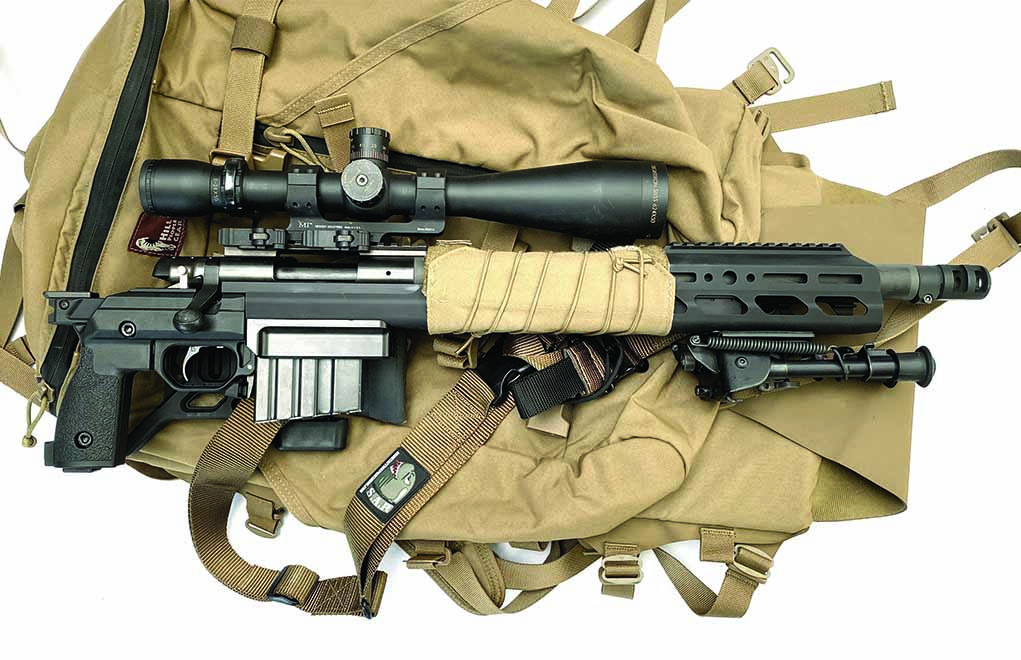
Is cost the only detriment? Well, in my experience, carbon fiber can be misapplied for certain roles. To illustrate best practice, I built or received three rifles that make use of various carbon-fiber parts from several different manufacturers. It’s possible to make a rifle that’s too light for a given role, and it’s also possible to be severely disappointed by what you receive if you buy into the hype.
The cons discussion here is meant to be honest, and, despite common claims, a carbon-fiber barrel isn’t any more accurate than a steel barrel, considering that it’s itself a steel core with steel rifling. The mechanical and physical principles of accuracy don’t change here, nor does relative velocity of a given bullet when fired through carbon-fiber-wrapped barrels of plain steel barrels. Simply adding a carbon-fiber barrel to your rifle isn’t guaranteed to make it shoot better. The basic thing a carbon-fiber barrel offers is substantial weight savings over a steel barrel of the same contour, with the added benefit of faster heat bleed-off and rigidity to weight.
So, wouldn’t it be more accurate if it’s stiffer? Well, take into account that most standard carbon-fiber barrels are meant to mimic the profile of common heavy barreled guns, the idea being that common stocks would still work without much fitting. The common profile for these barrels is the same as the military M24 contour, with the next popular contour being Remington Sendero, a heavy-class hunting profile thinner than M24 but thicker than a standard hunting-weight barrel. Side by side, a 24-inch M24 contour carbon-fiber barrel won’t outshoot a 24-inch M24 contour steel barrel on paper, but it’ll weigh only one third of what the steel barrel weighs as a rough rule of thumb.
There are some out there who claim a carbon-fiber barrel will last longer than a plain steel barrel, sometimes to the tune of twice the accurate life. This means, in theory, that a .308 Winchester with a carbon-fiber barrel would have an expected accurate life of 10,000 or more rounds, so you’d never need another one if that were true.
Contrary to popular belief, it’s not the rifling that wears out but rather the throat and start of the rifling. These areas are susceptible to heat-imposed damage and eventually erode enough to make it so that the bullet has to jump or enter the rifling off-center. High-volume shooters with hot cartridges like 6.5 Creedmoor—a round known for poor barrel life—are enthusiastic about carbon-fiber barrels due to their ability to radiate heat quickly as opposed to steel.

Now, a reality check is that this really only applies to people who shoot their 6.5 CM enough to see a reduction in accuracy, not their barrel being blown out into a smooth bore. What does this mean? The average person will never in their life shoot a barrel “out,” and shooting a barrel out for a competitor means they might go from shooting ¼ inch at 100 yards to ¾ inch at the same distance over 3,000 rounds, which is the general “accurate” life of a standard 6.5 CM barrel.
What you need to understand is that carbon-fiber barrels give a slight edge to high-volume competitors at ranges past 800 yards against steel barrels, but this isn’t the norm for most people, and there’s no reason you won’t get a decade of use out of a steel barrel for use in competition before you start to notice it’s no longer consistent at those long ranges.
The positives of carbon-fiber barrels are primarily centered around weight savings and accuracy for a given complete rifle weight. It’s true that you can shave literal pounds off a rifle by switching to a carbon-fiber barrel, especially if you had a heavy-contoured barrel on your existing rifle. If you have a mountain-class light rifle, remodeling your rifle to use a carbon barrel will allow you to keep the short length but add tremendous stiffness and accuracy for the same weight. Short, light rifles suffer from heat-related accuracy problems more than other guns, and it’s very noticeable.
Heat dispersion for hunters isn’t really a big deal and only comes into play when you’re at the range practicing or developing loads for your rifle. Some hunting rifles with skinny barrels are hard to zero and lose accuracy after just a few rounds due to heat buildup. The weight savings is nice in the field but isn’t much of a factor unless you’re climbing or walking. A stand hunter isn’t benefited by this much at all, considering the stationary nature of that type of hunting; weight just isn’t that important, since you’re just walking up to the blind with a nice thermos of coffee, snacks and a book to read.
There really isn’t too much of a debate around carbon-fiber stocks. Stocks are somewhat basic in nature and haven’t changed all that much in the last hundred or more years. A carbon-fiber stock is quite rigid, but not as stiff as a metal chassis. The weight savings over wood, composite or polymer stocks isn’t the same ratio as barrels, so expect to shave about 10 to 20 percent in total weight over a comparably sized conventional stock.
A Look At Upgrades
The three rifles in this article are designed for very different purposes, and all make use of carbon-fiber parts to achieve their ends. The first of these is a top-shelf hunting rifle from Mesa Precision Arms; it was built from the ground up to take full advantage of modern materials and techniques. It’s a hunting rifle chambered for 6.5 Creedmoor, and capable of ½ MOA at ranges to 1,000 yards. It does take considerable practice to use so light a rifle at so long a distance, but it’s not ethical or even likely that you’d be firing on an animal at target distances like that. This rifle excels at ranges inside 800 yards and is a charm for the pack-in hunter with multi-species tags.
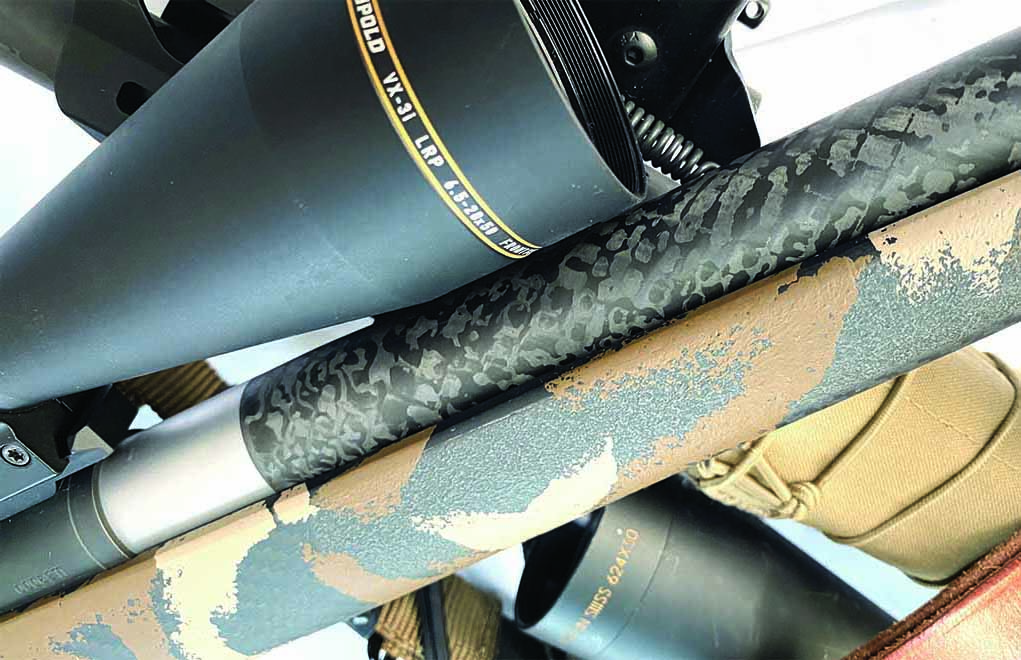
The Mesa has a carbon-fiber stock and barrel and a titanium action. This is a specialty product that’ll almost certainly not be in the safe of the recreational deer hunter. This rifle retails around $5,000 as featured in this article, but it’s truly peerless in terms of raw performance, even against other rifles that use nearly identical components. The lightweight package is specialized and fully tuned with minor details you won’t see, and it shows in field use. This product is representative of just what can be accomplished when technology and craftsmanship are applied in unison. There’s a vast difference in a custom carbon-fiber rifle built by a company that specializes in those materials and a company that simply adds to a product in their existing catalog.
The next rifle is my personal deer rifle, the action custom blueprinted by the fine folks at Precision Rifle Company in my native Michigan. They’re a leader in making accurate rifles that use straight-walled cases, mine being a 14.5-inch pin-and-weld .450 Bushmaster. This rifle uses an AG Composites Alpine Hunter carbon-fiber stock.
Why use a target-style carbon-fiber stock on a big-bore rifle with a cartridge good to 200 yards? The rifle is a special build in that it’s completely specialized for Michigan hunting. I’m an open-field stalk hunter, for the most part, and I rarely if ever use a stand, instead remaining on the ground in blind corners of wheat, soybean or corn stubble. This rifle has the shape necessary for positional shooting unsupported but is light enough that it can be carried easily over distance and in dense cover. A carbon stock makes total sense in this respect, as I can save weight while getting the benefits of a more robust stock.
The last rifle is another specialized custom-built Remington 700 in a KRG Whiskey 3 folding chassis. The rifle uses a rather unique barrel setup, that being a Savage-style finished-chamber with a barrel nut assembly. It’s from X-Caliber barrels, which also manufactured the standard steel barrel on my .450 Bushmaster. The barrel nut setup makes it so that you can install the barrel yourself at home on a standard, non-trued 700 action. The result is a drop-in carbon-fiber solution if you want to try your hand.
This barrel is chambered in 6.5 Creedmoor and is 16 inches long. The idea was to make a compact rifle for tactical shooting competition that made good use of 120-grain bullets at high velocity. The 6.5 CM is hot, and this short, stiff barrel bleeds heat while being exceptionally compact with no loss of accuracy or velocity. It launches 120-grain bullets at 2,700 to 2,900 fps, depending on factory or hand-load used. It shoots inside .308 Winchester at virtually all distances with almost no recoil.
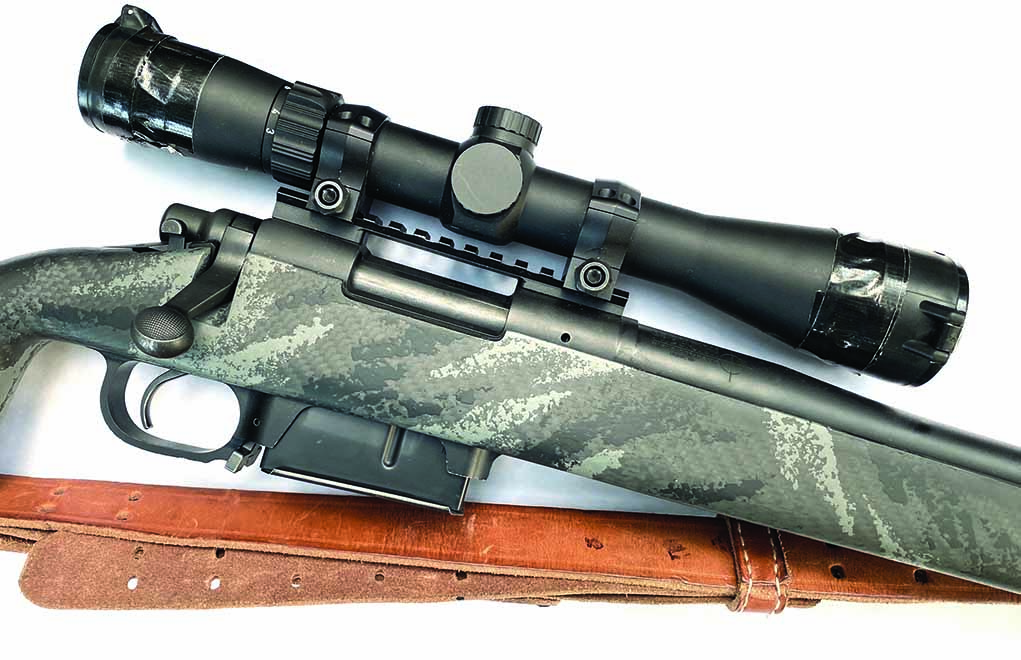
Specialized uses like this strongly favor carbon-fiber barrels. High-round count and mobility are key here, and a carbon-fiber barrel makes total sense to keep the rifle cool while saving weight and fatigue when moving it. Choosing to build a rifle around a bullet can change your approach, and this one went through several iterations with expert input to get it right, and the X-Caliber barrel here made all the difference.
Cost And Benefits
The truth of it is you might not be benefited by carbon-fiber upgrades if your end use doesn’t involve weight savings or heat dissipation. Cost is certainly a factor here, and the price of upgrades can usually buy you a whole new rifle or a new scope. Carbon-fiber barrels aren’t cheap and can run well over $1,000, not even counting chambering and fitting. Carbon-fiber stocks are more feasible, but they don’t provide significant performance enhancements at the end of the day as compared to conventional stocks.
As this technology marches on, it’ll certainly improve and begin appearing in more places. Today’s carbon-fiber game is still in its infancy. In 10 years, it’ll be likely that this material will be cheaper to produce and will find more end uses, but in our time, it’s still a specialized product best suited for the few who want to pay for a perceived edge.
The article originally appeared in the December 2020 issue of Gun Digest the Magazine.

Next Step: Get your FREE Printable Target Pack
Enhance your shooting precision with our 62 MOA Targets, perfect for rifles and handguns. Crafted in collaboration with Storm Tactical for accuracy and versatility.
Subscribe to the Gun Digest email newsletter and get your downloadable target pack sent straight to your inbox. Stay updated with the latest firearms info in the industry.

![Best Concealed Carry Guns In 2025 [Field Tested] Wilson Combat EDC X9S 1](https://gundigest.com/wp-content/uploads/Wilson-Combat-EDC-X9S-1-324x160.jpg)


![Best 9mm Carbine: Affordable PCCs [Tested] Ruger Carbine Shooting](https://gundigest.com/wp-content/uploads/Ruger-Carbine-Shooting-100x70.jpg)
![Best AR-15: Top Options Available Today [Field Tested] Harrington and Richardson PSA XM177E2 feature](https://gundigest.com/wp-content/uploads/Harrington-and-Richardson-PSA-XM177E2-feature-100x70.jpg)

Lost me when you listed 6.5 cm as a hot cartridge with poor barrel life.
For long range hunting here in Nevada I have a 6.5 PRC Browning X-Bolt Pro. The “Pro” models all come with a carbon fiber stock. It is filled with a dense foam and some solid CF blocks are set in where the recoil lugs and sling swivels are. Then it is very nicely bedded at both recoil lug area and rear action bolt area.
The Pro is burnt bronze Cerakoted and the CF stock looks nice and is lightly Cerakoted to match the metal but also still shows the CF weave. I may change the swivels fo flush cups bot otherwise I like the stock.
At 6 lbs. 3 oz. it is light enough to be in the “mountain rifle” category. With that skinny fluted barrel after 3 shots it Does open up groups from 1/2 MOA to 1 1/4 MOA – still “minute of deer” at 200 yards. But this is a hunting rifle and If I can’t kill my game with 3 shots I need to find another sport.
Eric B.